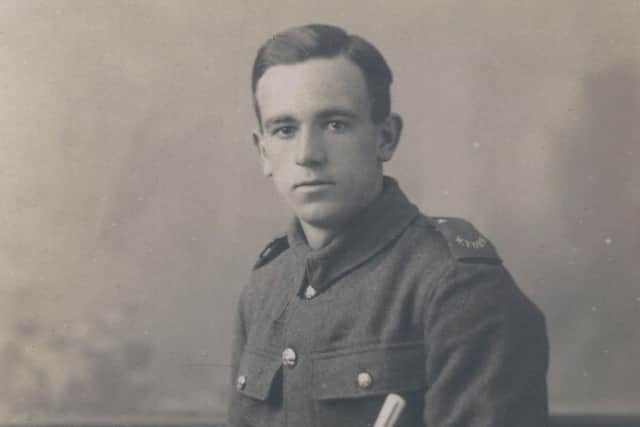The Nostalgia column with Margaret Watson


They have all been rich in social history and have painted vibrant pictures of what life was like in Dewsbury.
But the article sent in this week by Mrs Barbara Lumb tells us something which I hope we will never forget.
Advertisement
Hide AdAdvertisement
Hide AdIt is a story of the supreme sacrifice which her great uncle made during World War One, and also the research she has done on this young man’s life.


Barbara, who was born in Dewsbury, but who now lives in Liversedge, is a descendant of Private Leonard Halstead, of Thornhill, who was tragically killed in the Somme Valley a hundred years ago next month.
She has been researching Leonard’s war records for some years and also visiting the battlefields where he fought and was killed.
Barbara has also compiled an illustrated booklet of Leonard’s life which she will be presenting in due course to family, friends, Thornhill Parish Church and Thornhill Methodist Church.
Advertisement
Hide AdAdvertisement
Hide AdShe believes it is quite remarkable that despite the chaos and carnage of WW1 she has been able to find out so much about Leonard’s war record, how he died and where he was killed.


Most of this information she was able to acquire due to the kind actions of an eyewitness to Leonard’s death, Company Sgt Major E Moore.
It was he who took the pay book and family photographs from Leonard’s body shortly after he was killed and only hours before he himself was captured by the Germans.
He kept them in safe keeping until the end of the war when he was released from the prison camp. One of the most moving aspects of Barbara’s story is how Sgt Major Moore, following his release, travelled from his home in Rotherham to Thornhill to present Leonard’s personal possessions to his parents.
Advertisement
Hide AdAdvertisement
Hide AdThese items, lovingly kept by his family for a hundred years, were to prove the starting point for Barbara’s research of Leonard’s life.
The following is part of the article Barbara has written to include in her booklet of Leonard’s life:
“The Regimental War Diaries gave me a day-by-day account of Leonard’s movements and activities.
“Last year I went with my husband David on a bespoke battlefield tour to actually see the places where Leonard served in Flanders and France from 1915 to 1918.
“Leonard was my grandfather Arthur’s brother.
Advertisement
Hide AdAdvertisement
Hide Ad“He was born in 1895 in Thornhill, the youngest of eight sons born to my great grandparents, Richard and Mary Hannah Halstead, a family of colliers working at Combs Pit.
“The three youngest sons, Arthur, Milton and Leonard, enlisted in the army in 1915 and Leonard joined a Pioneer Battalion of the Prince of Wales West Yorkshire Regiment.
“I found out a lot about the Pioneers, who acted as the ‘workhorse’ for the Royal Engineers which left the Infantry battalions more time for fighting.
“Even so, Leonard was trained in basic infantry skills, and the war diaries for the Pioneers describe the relentless hard physical work they had to do.
Advertisement
Hide AdAdvertisement
Hide Ad“They had to build and repair trenches and communication trenches, roads, railways and bridges; wiring, and battlefield clearing, which must have been the hardest, having to recover the dead and digging graves, all the while taking casualties themselves.
“One of the cemeteries Leonard worked on, and one which we visited, was Sucrerie Cemetery, which was a long narrow piece of land next to a minor road.
“In my imagination I saw Leonard looking up from his work and seeing fresh troops marching along that country road towards the front line and looking across at those empty, waiting graves.
“That was in the first week of July 1916.
“The following two entries in the War Diaries give an idea of the conditions and the relentless hard work he would endure:
Advertisement
Hide AdAdvertisement
Hide Ad“‘Thaw began today (February 15 1917) and work became very difficult. No moon at night and solid ice under about three inches of slush. The trenches are so flooded that they need constant pumping.
“‘8 September 1917 Battalion marched to Camp at Blairville for rest and training, having been at work continuously since 30 April’
“As the casualties grew, Leonard was transferred, along with hundreds more Pioneers, to the 1st Battalion of the West Yorkshires in preparation for the expected major German offensive.
“And on 21 March 1918 – the day he was killed – Leonard’s Battalion was in the front line when the Germans launched their last ‘Big Push,’ a dramatic assault intended to end the war.
Advertisement
Hide AdAdvertisement
Hide Ad“It was preceded by the biggest artillery barrage of the war when 3.5 million shells (including gas) were fired at the entire British Front along the Somme.
“General Ludendorff’s attack was spearheaded by ‘sturmtruppen’, who were specially trained elite troops armed with weaponry to enable a rapid advance and supported by fighter aircraft, followed by regular troops.
“The West Yorkshires did put up fierce resistance, but even so they were pushed back to the reserve trenches where they fought in hand to hand combat, only withdrawing after running out of ammunition at 7.15pm.
“But by then Leonard was dead, and testament to the heroic resistance displayed by the West Yorkshires, is indicated in the casualty roll call taken at the end of that day.
Advertisement
Hide AdAdvertisement
Hide Ad“In Leonard’s Brigade section of the front line the losses were 69 Officers and 1,401 ‘other ranks’, and many more were taken prisoner.
“Most of the dead had no known grave and Leonard’s name, like thousands more is inscribed on the Memorial at Arras.
“So this year, on 21 March, the centenary of his death, as I lay a poppy wreath on the War Memorial in the graveyard of St Michael and All Angels Church, Thornhill, I will think of Leonard.
“I will try and imagine the grief of his parents, Richard and Mary Hannah, as they opened the door of No. 98 Chapel Lane, Thornhill, to Company Sergeant Major Moore, to be told the circumstances of their beloved son’s death.
Advertisement
Hide AdAdvertisement
Hide Ad“And, in a footnote to this, General Ludendorff called his attack that day “Operation Michael”, after one of the patron saints of Germany; the irony being that Thornhill Church was named after the very same saint.
“I couldn’t let this anniversary pass without preparing an illustrated booklet about Leonard to give to Thornhill Parish Church and Thornhill Methodist Church and to family and friends.
“It was the very least I could do to honour a young man who, like so many others, paid the ultimate sacrifice.”
If you have stories to tell, memories to share, or photographs to show, please email me at [email protected]. I will be most grateful to hear from you.